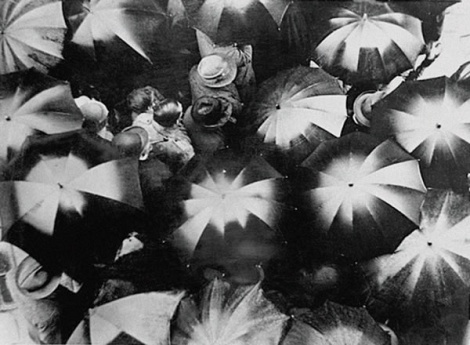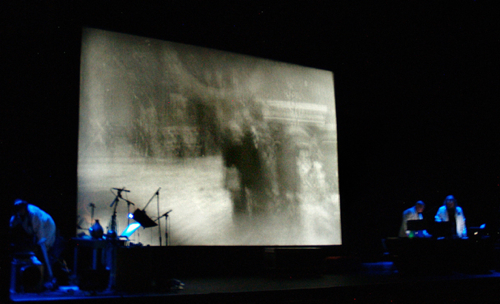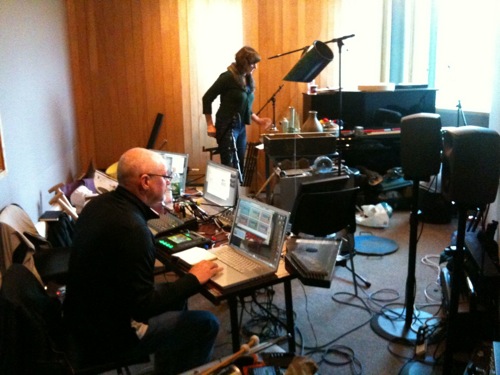Re-Mediating Joris Ivens
The Softday Foley Ensemble, Cork Film Festival

Softday was joined by Caoimhe Doyle and Jean McGrath, creating live Foley and sound to Joris Ivens' films RAIN (REGEN) from 1929 and THE BRIDGE (DE BRUG) from 1928. This this specially commissioned performance honouring the work of the legendary Dutch filmmaker was sponsored by the Cork Film Festival and Cork City Council.

Softday Foley Ensemble on stage at the Cork Opera House
Courtesy of Jim Clancy

Softday Foley Ensemble rehearsing in a studio at the University of Limerick
Re-Mediating Joris Ivens
Essay by Dr. Dara Waldron
'The documentary must not remain a grounds for emotional or literary excitement at the beauty of matter, it must draw reactions and provoke latent activitites,' Joris Ivens.
I want to begin this talk about Joris Ivens and Softday by briefly recapping on how the project materialised. Last January, I spent a number of days with the documentary British filmmaker and academic Gideon Koppel, who came to Limerick School of Art and Design as part of the visiting lecture series. One of the points of discussion during Gideon's stay was the origins of documentary film: how the movement began in an avant-garde whose main practitioners saw themselves as artists and filmmakers. Documentary, in its development, was a form of filmmaking that dealt with actuality, or with what John Grierson famously described as the 'creative treatment of actuality' - but that didn't mean seeing 'creativity' as a threat. From its inception documentary was a genre which looked beyond the studio setting. The pioneering filmmakers, Vertov, Ruttman, Dovschenko etc. reacted against the feature film by turning to actual life. Over the years, or up until maybe twenty years ago, the genre, or at least, the dominant variant (revived from outside official institutions), has been colonised by television; and documentarians like Koppel marginalized in the process.
Before leaving Gideon recommended Mark Cousins and Kevin McDonald's Faber Book of Documentary as a textbook on this topic, which I promptly sourced. On delivery I came across an article called Rain by Joris Ivens. I was struck by the tone and simplicity of the idea of filming rain that Ivens wrote about. Ivens spoke about something as an Irishman I had experienced (a lot of), making it seem like a spiritual entity for testing human resolve. Soon after reading this text, Softday approached me about collaborating on this project, with the hope that Caoimhe Doyle and Jean McGrath, internationally renowned Foley artists, would also be involved. It all seemed like a curious case of serendipity: the first Softday project I encountered was, coincidently, about rain, the Irish variant, as a source of sonic inspiration. What Ivens had sought in silent images, Softday had sought in sound. I photocopied the text Rain and suggested reading it followed by a viewing of Ivens documentary. Within days, the project was borne but on one condition, that we work not just with Rain (1929) but The Bridge (1928): both of which Joris Ivens made in Holland, while director of Capi films. I watched both, and for some reason thought The Bridge had been made in the aftermath of Rain.
This latter point is important. In my discussion with Gideon on the aesthetics of the documentary film and I began to wonder if documentary - by its nature - could be considered in this way. In other words, could we think of past documentary film as an aesthetic experience of the now; that 'showing' a 'then' could be mistaken for depicting a 'now.' The idea that depicting something, which doesn't always concord with its real nature, was the same as documenting it, seemed dangerous. In this latter sense, I wondered if documentary film, based on actual time and space 'never to be repeated,' could show something other to that which it pertains to represent. In other words, could Ivens' Rain and The Bridge, aligned together as one, say something about our present?
In Rain and The Bridge Ivens gave birth to a genre. Indebted to the German filmmaker Walter Ruttman, Rain takes the form of a city symphony (of the Ruttman's variety), where citizens - amidst the man-made repository of the city - react to the elements. Urbanites confront rain. Images of the masses running to take shelter are interspersed with umbrellas 'seen' from above, in what appears to be a curious sort of order. In The Bridge these elements are overcome; the bridge crossing the Maas river in Rotterdam, a 'mini-event' standing for the glory of the modern. Both prefigure a lifetime preoccupation, for a 'committed documentarian,' as Walter Benjamin described him, concerned with collective modern life. The bridge (in The Bridge) alters lives for the better; but it can also be said, albeit controversially, to stand for film itself. 'Just as the dynamic dramas of bridges and pile drives yield tangible results possessing use-value', Bill Nichols notes, 'the film's dynamic dramatization of events possesses use-value of its own: a new account of the world and its potential for change.' By change, Nichols means documentary's capacity to instigate as well as record change.
After Rain and The Bridge Ivens' films became less poetic, many of his later films documenting political struggle, as in The Spanish Earth (1937), or in Non-Western countries; notably China and North Vietnam. His lifetime commitment to communism and the official social realism associated with it has overshadowed his celebrity as an avant-garde modernist: someone who saw the film as a truly modern media. His critical reduction to communist filmmaker, concerned only with representing 'struggle,' tends to conceal the fact that his silent films invite re-mediation; speaking of universal as well as local truths.
In the 1950s Ivens came to Cork. Like us, he came because of film. Little did he know that his films would be shown here over sixty years later, in celebration of his life. For his life comprises the twentieth century, and his films, from their modernist to social realist phase (to the collaborations with Marceline Loridan-Ivens) span the technical developments of film. Sound is just one of these developments. It may seem strange to score these films but the project was borne from wanting to work with the pictorial nature of sound, sound as music. This meant not so much re-imagining the films but bringing out what was already immanent to them. My discussion with Softday related to immanence, described as that which is already in the artworks. Re-mediation, which isn't new communication, emerges from the already there, the immanent of the 'there.'
With these concerns, it is apt to consider Ivens' feeling about sound and music. In the 1930s, when working with Hans Eisler, Ivens was asked how he related to the use of sound in film. He spoke about music as a showing, forming a symbiosis with the pictorial element. In the decade previous the Austrian philosopher, Ludwig Wittgenstein had famously distinguished between saying and showing, giving birth to the now infamous picture theory. As if pre-empting the influence this would have, Ivens spoke about the pictorial nature of music and sound. 'The music has a function' Ivens said 'doesn't it?' to which he would respond 'perhaps its task is being silent?' He would then go on to state 'after all, you have the sound, the text, the music and the picture.....now the music has priority and the picture can be very restrained because the picture can be very rhythmic' or 'now the music has to be silent because the original sound is much more beautiful.'
The musing of a filmmaker borne of the silent period. The balancing act Ivens speaks of opens up problems to the auspices of the shown. It is in entertaining such problems that the Softday Foley Orchestra have breathed new life into pictures of the silent past. Taking Ivens at his word, the 'original' was shown, only to be re-mediated. Pictures began to multiply. Sound was silenced by music and vice versa. Music imbibed pictures, and sound made pictures out of pictures. We were brought back, in a kind of mysterious interlude, to our opening gambit; Ivens' silence speaking to our present.
Dr. Dara Waldron is Lecturer in Critical and Contextual Studies in Limerick School of Art and Design, where he teaches film and visual culture. His area of research centres on the intersection of film, ethics and moving images. He has published widely in this area.

